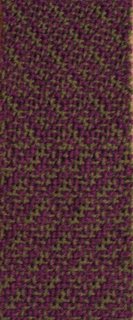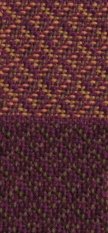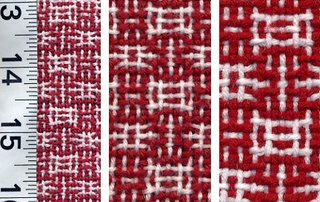Valerie asked about grist and sett for the yarns I’ve been using for my shadow weave samples. I had to stop and go look for this information, in fact I even used my McMorrin yarn balance for the first time.
I doing this I became aware of two things:
Firstly, I realized that grist doesn’t really mean anything to me. I know the definition, but that is only intellectual knowledge. Experientially, I don’t know what to do with that information.
As a handspinner I am most familiar with WPI (wraps per inch), so this is what I apply to both knitting and weaving as well. Gauge and grist? Well, I have to stop and think about them. I have to reason through what they mean to me and the project I want to work on. WPI? I can run with that.
Secondly, I realized that even though I am trying to keep better records with my shadow weave samples, there are still informational gaps in what I record on my worksheets. I am writing more things down and doing a better job of recording all the information in the same place, but , I have been realizing that I rely on my memory way too much. For some reason when I look at a weaving sample, or a handspun skein, or knitting pattern, I assume that I’ll remember more than I actually do.
Consequently I have a dozen or so oddball sample skeins from fleeces whose breed and origin I don’t remember. I have several cones of weaving yarns with the labels misplaced. And I have several pairs of socks with mates which don’t fit the same because I couldn’t remember the exact modifications I made, or number of stitches I picked up. (Or, more likely, I misplaced the scrap of paper I jotted the information down on.) And to all this I’m now adding weaving samples with odd bits of information missing.
I’m not consistently scatter brained. I do have a nice file box of spinning cards with control yarns and notes on them, and I have learned to keep a sock knitting notebook with a page for each person I knit socks for. And most of the time I manage to jot down all measurements, calculations, and changes.
Weaving is a little easier because I have to write everything down in order to calculate yarn amounts for warp and weft measurements. And recently I purchased a 3-ring binder for my weaving notes and samples. So I am making progress, though at times I don’t feel like it.
Anyway, if you’ve gotten through all that and are still interested, here is the yarn information:

The yarn for the
scarves:
590 yds per lb
Sett 5 epi

Worsted weight knitting yarn
samples:
832 yds per lb
Sett 8 epi

The sock yarn samples:
2000 yds per lb
Sett, I'm not sure. I thought I used 10 epi for the red and white samples, but I wasn't happy with it. So for the orange and fair isle sock yarn
sample, I used a sett of 12 epi and it made a much denser fabric. I liked it better, but it is hard to believe that only 2 ends per inch could make such a difference in the fabric. So I'm wondering if the specific shadow weave drafts make a difference. Does anybody have any experience with this?

8/2 cotton
3360 yds per lb
Sett 16 epi (fabric too loose, structurally)

16/2 cotton
6650 yds per lb
Sett 24 epi
After all that, I realized that the only way I will ever be able to use grist intuitively, is to pay attention to it and faithfully keep a record of it for the yarns I use. It may seem like more work right now, but I have faith that it will eventually pay off.
© 2006 Leigh's Fiber Journal






































